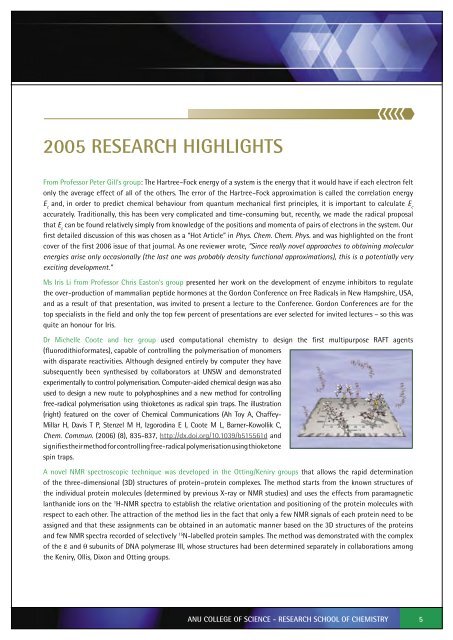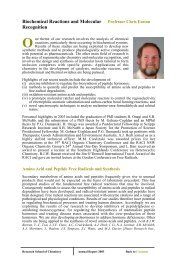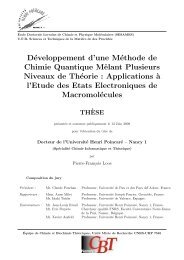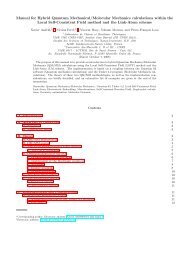View 2005 Report - RSC - Australian National University
View 2005 Report - RSC - Australian National University
View 2005 Report - RSC - Australian National University
You also want an ePaper? Increase the reach of your titles
YUMPU automatically turns print PDFs into web optimized ePapers that Google loves.
<strong>2005</strong> RESEARCH HIGHLIGHTS<br />
From Professor Peter Gill’s group: The Hartree–Fock energy of a system is the energy that it would have if each electron felt<br />
only the average effect of all of the others. The error of the Hartree–Fock approximation is called the correlation energy<br />
E c<br />
and, in order to predict chemical behaviour from quantum mechanical first principles, it is important to calculate E c<br />
accurately. Traditionally, this has been very complicated and time-consuming but, recently, we made the radical proposal<br />
that E c<br />
can be found relatively simply from knowledge of the positions and momenta of pairs of electrons in the system. Our<br />
first detailed discussion of this was chosen as a “Hot Article” in Phys. Chem. Chem. Phys. and was highlighted on the front<br />
cover of the first 2006 issue of that journal. As one reviewer wrote, “Since really novel approaches to obtaining molecular<br />
energies arise only occasionally (the last one was probably density functional approximations), this is a potentially very<br />
exciting development.”<br />
Ms Iris Li from Professor Chris Easton’s group presented her work on the development of enzyme inhibitors to regulate<br />
the over-production of mammalian peptide hormones at the Gordon Conference on Free Radicals in New Hampshire, USA,<br />
and as a result of that presentation, was invited to present a lecture to the Conference. Gordon Conferences are for the<br />
top specialists in the field and only the top few percent of presentations are ever selected for invited lectures – so this was<br />
quite an honour for Iris.<br />
Dr Michelle Coote and her group used computational chemistry to design the first multipurpose RAFT agents<br />
(fluorodithioformates), capable of controlling the polymerisation of monomers<br />
with disparate reactivities. Although designed entirely by computer they have<br />
subsequently been synthesised by collaborators at UNSW and demonstrated<br />
experimentally to control polymerisation. Computer-aided chemical design was also<br />
used to design a new route to polyphosphines and a new method for controlling<br />
free-radical polymerisation using thioketones as radical spin traps. The illustration<br />
(right) featured on the cover of Chemical Communications (Ah Toy A, Chaffey-<br />
Millar H, Davis T P, Stenzel M H, Izgorodina E I, Coote M L, Barner-Kowollik C,<br />
Chem. Commun. (2006) (8), 835-837, http://dx.doi.org/10.1039/b515561d and<br />
signifies their method for controlling free-radical polymerisation using thioketone<br />
spin traps.<br />
A novel NMR spectroscopic technique was developed in the Otting/Keniry groups that allows the rapid determination<br />
of the three-dimensional (3D) structures of protein–protein complexes. The method starts from the known structures of<br />
the individual protein molecules (determined by previous X-ray or NMR studies) and uses the effects from paramagnetic<br />
lanthanide ions on the 1 H-NMR spectra to establish the relative orientation and positioning of the protein molecules with<br />
respect to each other. The attraction of the method lies in the fact that only a few NMR signals of each protein need to be<br />
assigned and that these assignments can be obtained in an automatic manner based on the 3D structures of the proteins<br />
and few NMR spectra recorded of selectively 15 N-labelled protein samples. The method was demonstrated with the complex<br />
of the ε and θ subunits of DNA polymerase III, whose structures had been determined separately in collaborations among<br />
the Keniry, Ollis, Dixon and Otting groups.<br />
ANU COLLEGE OF SCIENCE - RESEARCH SCHOOL OF CHEMISTRY<br />
5






